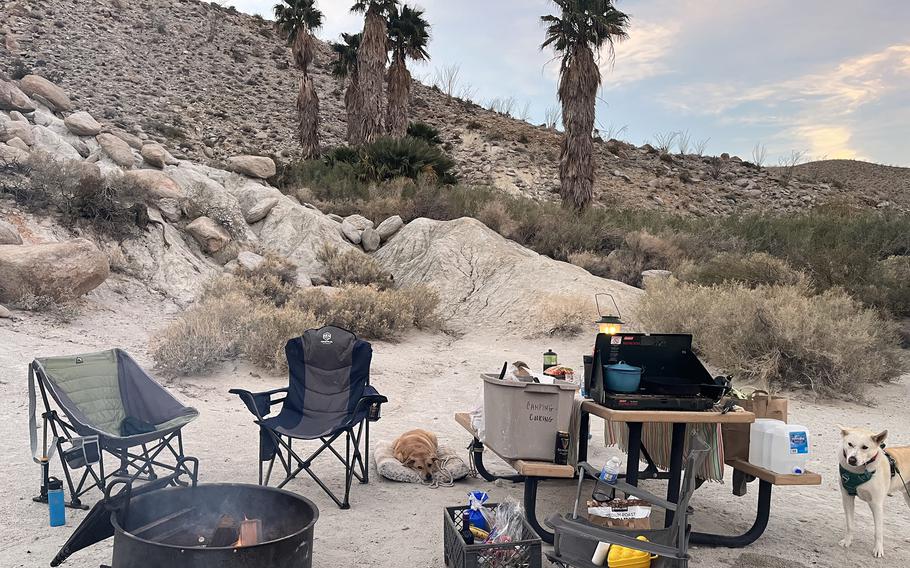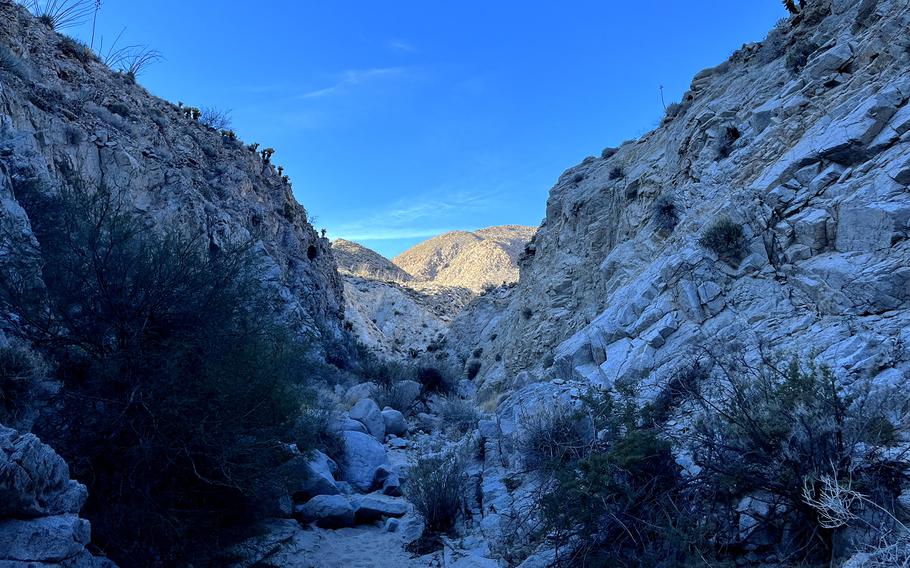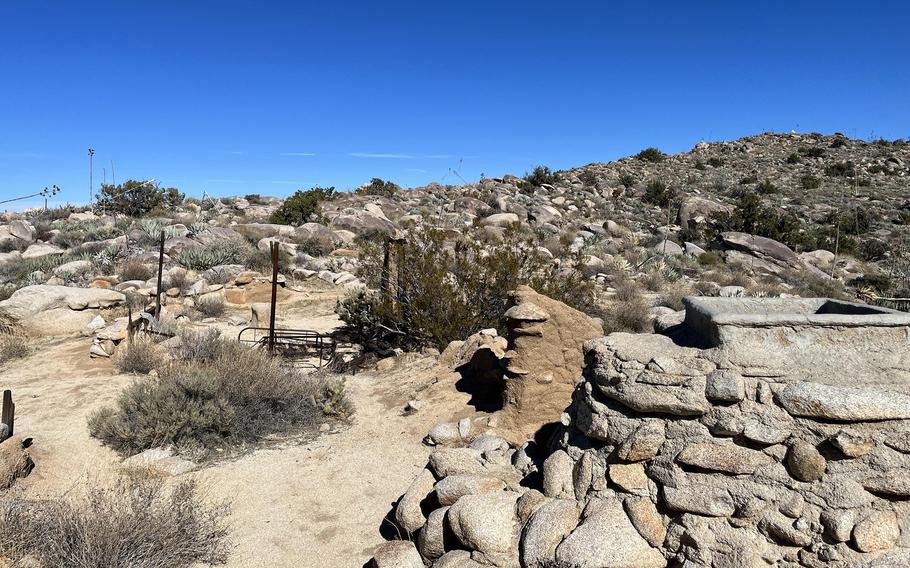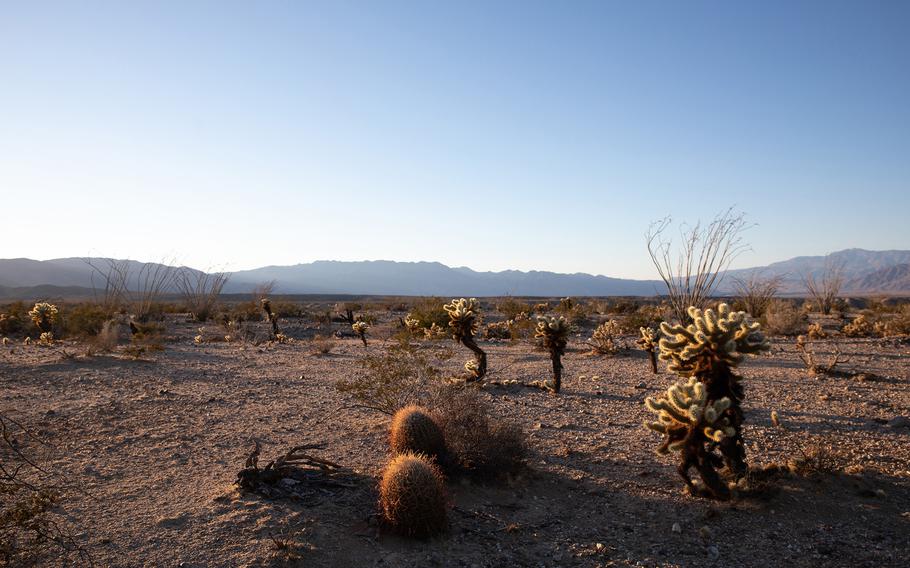
The author’s campsite setup at Agua Caliente County Park, an organized campground with tent and recreational vehicle campsites, cabins with air conditioning and heat, bathrooms with showers and even an amphitheater where the park sometimes hosts educational presentations. Other paid designated campgrounds are also available as are more primitive campgrounds; visitors may also be interested in dispersed camping, which is done on public lands outside of a designated campground. (Maura Fox, The San Diego Union-Tribune/TNS)
SAN DIEGO — Few places are as vast and ever-changing as the desert, where the landscape shifts with the seasons and life impressively thrives in a hostile environment.
One of the best ways for Southwesterners to enjoy this dynamic is by camping in San Diego County’s backyard desert, the Anza-Borrego, where State Parks protects more than 600,000 acres of land — the largest state park in California. The months from roughly November to April are considered the desert season, when visitors can avoid extreme heat during the day and catch potential wildflower blooms.
“Each part of the park is really unique and there are so many different types of things you can see,” said Samantha Young, the education manager at the Anza-Borrego Foundation, pointing to features such as dunes, badlands and palm oases. “It even goes up into the mountains in some portions.”
Along with its size and diversity, Anza-Borrego provides an uncommon experience for visitors: Camping is permitted nearly everywhere in the park, as long as the site is set up a safe distance off a road.
It’s also considered a “trailless park,” Young said, meaning that hikers don’t have to be on a trail while they’re out exploring. There are still several designated campgrounds and hiking trails, though.
Desert camping can also be a great introduction for first-time campers, Young said, since it’s easy to find a flat surface to pitch a tent and there aren’t constant flies or mosquitoes.
“We do have plenty of insects and wildlife, but it doesn’t feel like it’s in your face,” she said.
Here’s what else to know about camping in the Anza-Borrego desert:
Where to camp
Desert camping will look different depending on the kind of experience visitors are seeking. There are designated campgrounds, which can cost around $30 per night, plus more primitive sites and dispersed camping, which are free options. Visitors should decide which type of camping they want to do, then review a map to determine where in the park they want to explore.
Each style of camping has its benefits. In reporting this story, the home base was Agua Caliente County Park, an organized campground with tent and recreational vehicle campsites, cabins with air conditioning and heat, bathrooms with showers and even an amphitheater where the park sometimes hosts educational presentations.
Other designated campgrounds include Vallecito County Park, as well as campgrounds such as Borrego Palm Canyon and Tamarisk Grove that can be booked through the State Parks reservations website.
But a trip over to Blair Valley made it clear why primitive camping is preferable for many campers; despite fewer amenities, it’s more peaceful and the campsites are large. These campgrounds, which include others like Bow Willow, are often first come, first served, and in some cases, campers will need to bring their own fire rings, since ground fires are prohibited in the park.
If visitors are interested in dispersed camping, which is done on public lands outside of a designated campground, Young said it’s important to “do your homework first” and read up on the park’s resources and road conditions. She also emphasizes the importance of leaving no trace when backcountry camping.
“This is always an awkward subject, but in the desert, it’s recommended that you pack in and pack out everything, including human waste,” she said. “In many places, you go to the bathroom in the forest and you bury it, but it doesn’t disintegrate in the same way in the desert.”
Desert camping safety
Even in the desert’s winter, it’s important to keep an eye on the weather. While daytime temperatures will likely be mild — in mid-January, the highs were in the 60s — they can drop by about 20 degrees at night, which is uncomfortable without proper clothing and gear. Check the forecast for rain before heading out, as well.
The desert is — naturally — very dry, so it’s wise to bring a lip balm or moisturizer for the skin. It’s also known for its high winds in the afternoons and evenings, Young said. Campers may find it difficult to sleep at night with wind rustling a tent and nearby vegetation, but it also can be hazardous if gear starts flying around, especially if there’s a nearby campfire.
Before going to sleep, secure anything that could be picked up by the wind, such as camp chairs, and put out a campfire. If tent camping, stake the tent into the ground or put rocks inside to make it heavier. Young also recommends setting the tent next to a hillside or behind a vehicle to create a protective barrier from the wind.
She also reminds campers to watch road conditions, which can shift with the rain and wind. And even without the weather, some desert roads require four-wheel drive.
“The road is very soft and sandy,” she said. “It’s always a good idea for people to be aware of the road in advance and know the capabilities of their car because people get stuck a lot.”
Hiking in the area
Campers can set out on a hike from anywhere in Anza-Borrego, with treks lasting from less than an hour to daylong adventures and backpacking trips. Even in the winter, bring a sufficient amount of water — about half a liter per hour is recommended for moderate activity in moderate temperatures — and use a compass or a map of the area to avoid getting lost.
Hiking in the desert also requires adaptability; it can be easy to get off trail and road conditions may prevent hikers from reaching their trailhead of choice. Note that dogs are not allowed on trails in the park and must be kept on a leash in campgrounds and on park roads.

Hiking through Moonlight Canyon, a 1.6-mile easy-to-moderate loop that is located near Agua Caliente County Park. Many hiking trails start in or near campgrounds. (Maura Fox, The San Diego Union-Tribune/TNS)
Many hiking trails start in or near campgrounds. For example, the Moonlight Canyon Trail, a 1.6-mile easy-to-moderate loop, starts at Agua Caliente County Park and takes hikers through the shady Moonlight Canyon before traversing behind a mountain.
Then there’s the Marshal South Trail, a 2-mile moderate out-and-back hike on the southern side of Blair Valley. The trail climbs to the top of the 3,200-foot Ghost Mountain, where the writer and artist Marshal South moved with his wife in 1930. Hikers can tour the remnants of their home, which they called Yaquitepec, where they lived for 16 years and raised three children, using supplies they hauled up the mountain.

The remains of the South family’s home on the top of Ghost Mountain, on the southern end of Blair Valley. Writer and artist Marshal South moved there with his wife in 1930. Hikers can tour the remnants of their home, where they lived for 16 years and raised three children, using supplies they hauled up the mountain. (Maura Fox, The San Diego Union-Tribune/TNS)
Nearby areas and attractions
Hiking isn’t the only activity to do on an Anza-Borrego camping trip.
The desert and Borrego Springs — a small town located on the northern side of the park — are some of the best places to stargaze, since the state park is an International Dark-Sky Park and Borrego Springs is a designated Dark Sky Community.
In Borrego Springs, visitors will also find several restaurants, a farmers market on Fridays and Galleta Meadows, a sculpture park with giant metal prehistoric animals and creatures made by artist Ricardo Breceda.
Campers can also enjoy natural geothermal springs at Agua Caliente County Park, where there are three pools, free to Agua Caliente campers and $3 for a day pass.
Plus, starting around late February, there will be a chance to see the desert’s wildflower blooms. While this is a sight for all visitors, it’s an especially nice time to camp and spend some extended time in the park.
If all else fails, a simple drive along the county route S-2, which runs through the state park, is nearly guaranteed to deliver on beautiful scenery and history. The road dates to the 1700s, according to the Federal Highway Administration, when it was a dirt trail used by Spaniards, then later as a Mexican mail route in the 19th century and first paved in 1929.
Flora and fauna
Along with wildflower blooms in late winter, the Anza-Borrego desert also has incredible plants year round.
Keep an eye out for cactus, primarily cholla, “one of the most iconic plants in Anza-Borrego and the southwest region of the United States,” Young said. Worldwide, there are more than 30 different types of cholla cacti, and in the Anza-Borrego, it’s common to see jumping cholla, or teddy bear cholla, named after its fuzzy appearance.
Cholla branches may fall from the plant onto the desert floor, where they can eventually root and reproduce, so it’s best to wear sturdy hiking shoes to avoid a painful run-in. The barbs attach securely if brushed up against, so use tweezers, pliers or a rock to detach them if you fall prey.

Ocotillo, cholla, creosote and other desert plants grow in Anza-Borrego Desert State Park on March 8, 2022, in Borrego Springs, Calif. (Ana Ramirez, The San Diego Union-Tribune/TNS)
In terms of wildlife, campers may hear coyotes yipping in the distance or crossing a road and see birds like roadrunners scurrying through a campground, rattlesnakes and smaller critters, like lizards and rodents. (Campers should put away their food at night, such as in their vehicle, so rodents can’t snack on it while they sleep, Young advised.)
There’s also the chance to see the endangered peninsular bighorn sheep.
“We never promise that anyone’s going to see them. They camouflage incredibly well in the landscape,” Young said. “But they are out there.”